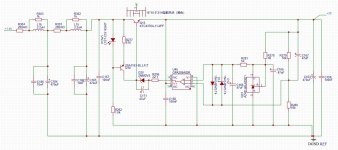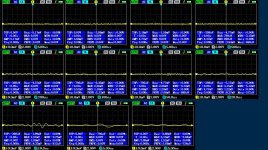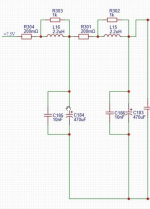Remote sensing makes the regulator more prone to oscillation because any cable inductances and parasitic capacitance of the wiring are now inside the feedback loop.
When I first tried the regulator my wiring was not 'dressed' in any way (read: it was a mess). When I bundled the ground and supply wires the oscillations became smaller and finally disappeared. I think this is mainly due to removing inductance from the feedback loop (bundling cables makes inductances smaller).
In the end I even removed the low pass filter from the sense connection without any instability problems (did not make an audible improvemen btw).
I have also found that the sense connections on the load must arrive at a decoupling cap. I couln't measure it, but the sound became less good when I connected a couple of cm away from the nearest decoupling cap (electrolytic).
Good luck with your endeavour. As always, you cannot expect this to work perfectly from the first try. In the end I was very happy with the result. Certainly worth the effort.
When I first tried the regulator my wiring was not 'dressed' in any way (read: it was a mess). When I bundled the ground and supply wires the oscillations became smaller and finally disappeared. I think this is mainly due to removing inductance from the feedback loop (bundling cables makes inductances smaller).
In the end I even removed the low pass filter from the sense connection without any instability problems (did not make an audible improvemen btw).
I have also found that the sense connections on the load must arrive at a decoupling cap. I couln't measure it, but the sound became less good when I connected a couple of cm away from the nearest decoupling cap (electrolytic).
Good luck with your endeavour. As always, you cannot expect this to work perfectly from the first try. In the end I was very happy with the result. Certainly worth the effort.
@ABO
good advice.
back in the day in TAA Richard Marsh posited that power supply wiring should be low inductance. he proposed a foil sandwich conductor "ribbon" be used to connect the regulated power supply to the circuit... and to tape it to the chassis on the way.
twisting gets you some of the way there. running the wire close against the chassis would likely help again. my problem with one project is my current layout forces wires to run away from any chassis.
by the way... one chap suggested connecting the senses at the respective pins of an opamp. there would be a cap there certainly. what do you think?
good advice.
back in the day in TAA Richard Marsh posited that power supply wiring should be low inductance. he proposed a foil sandwich conductor "ribbon" be used to connect the regulated power supply to the circuit... and to tape it to the chassis on the way.
twisting gets you some of the way there. running the wire close against the chassis would likely help again. my problem with one project is my current layout forces wires to run away from any chassis.
by the way... one chap suggested connecting the senses at the respective pins of an opamp. there would be a cap there certainly. what do you think?
Lumped-element transmission line model parameters for a coaxial cable show inductance as
𝐿′=(𝜇/2𝜋)ln(𝑏/𝑎)
where b is the outer conductor diameter and a is the inner conductor diameter and plastic insulators typically have 𝜇 not far from 4π x 10^-7.
Standard RG-59 has an outer to inner conductor diameter ratio of about 6 or 7 (4mm/0.6m), so with 𝜇 = 4π x 10^-7 series inductance is not far from 380 nH/metre. 30 cm would be about 110 to 120 nH, pretty close to an electrolytic capacitor ESL.
However, for really low inductance one could use the inner and outer shields of a Triax cable, where the outer shield has a diameter of 0.225 inch and the inner 0.145 inch, for a series inductance of 88 nH/metre, yielding an inductance of 26 nH for 30 cm of cable.
Markertek sells it for $2.59 a foot so you don't even need to break the piggy bank.
𝐿′=(𝜇/2𝜋)ln(𝑏/𝑎)
where b is the outer conductor diameter and a is the inner conductor diameter and plastic insulators typically have 𝜇 not far from 4π x 10^-7.
Standard RG-59 has an outer to inner conductor diameter ratio of about 6 or 7 (4mm/0.6m), so with 𝜇 = 4π x 10^-7 series inductance is not far from 380 nH/metre. 30 cm would be about 110 to 120 nH, pretty close to an electrolytic capacitor ESL.
However, for really low inductance one could use the inner and outer shields of a Triax cable, where the outer shield has a diameter of 0.225 inch and the inner 0.145 inch, for a series inductance of 88 nH/metre, yielding an inductance of 26 nH for 30 cm of cable.
Markertek sells it for $2.59 a foot so you don't even need to break the piggy bank.
Consider using Belden 1172A Star Quad with one "go" and three "returns" AND a shield. Sold here for $2.58 per foot. You're getting ultra-twist, ultra-braid thanks to the one-of-four assignment, then a shield as the cherry on top.
Capacitance conductor to conductor is about 40 pf/ft so not the end of the world, but the series inductance is 0.21 uH/ft and given the fun people have had with dressing cables maaaaybe that could be a consideration? I'd be glad to be proven wrong, of course, since the starquad is an elegant answer to the problem.
Actually I used ptfe hookup wire, twisted, shielded with alu foil and then heatshrink. I worked in a litze wire that I could solder to the pcb.
Note that cable geometry isn't that important since there is no current running through the shield. I greatly preferred this option to the balanced interconnect cable I had lying around.
Note that cable geometry isn't that important since there is no current running through the shield. I greatly preferred this option to the balanced interconnect cable I had lying around.
newby questions
I just ordered the board and am creating a mouser order
is a heat sink included with the board, if not are the holes spaced 1 inch apart?
what resistors do I need to set it at 12vdc?
is it ok to just use 2 connections at the output?
thanks
I just ordered the board and am creating a mouser order
is a heat sink included with the board, if not are the holes spaced 1 inch apart?
what resistors do I need to set it at 12vdc?
is it ok to just use 2 connections at the output?
thanks
https://diyaudiostore.com/products/super-regulator all your answers are here. Yes, you can use just 2 connections if you connect the sense connections to the two output connections.
the sense connections are necessary so... one has to use all 4 connections at the output of the regulator.
J.D. reg is amazing, got stable 5V, it drive 5 post regulators for 3.3V and 1,2V + two dsc2 discrete dac on 5V, about 200mA in total load to 5V J.D. this is device. It also contain 4 mini J.D. regulators +-15V for preamp, works also nice. Considering that this is digital circuity, 5V one fight it very well!? And this is the results:
Attachments
Last edited:
That filter is now mandatory in every my post-regulator before pre-regulator. I know that resistors should be 50 mohm, but I somehow using 200 mohm... simply no want to change something which works
Last edited:
If you use a balanced connection, the ground looses most of it's significance as it is no longer a reference for the signal.I settled on connecting the shield at the sense- connection at the source (amplifier side). The shield was lef unconnected at the regulator. I am not 100% sure that this is universally best though.
Rane, for instance makes the folowing recommendation for an interconnect that resemble this application. But I maintain that the other way sounded better in my system.
View attachment 1397096
Conneting as you did will most probably be fine. You have re-invented the relevant AES connection standard, congrats!
The Rane piece is worth having at the ready, very useful.
Jan
I am making a 12v supply for a lumin u1 mini streamer the load is 380ma . Can you suggest a good transformer / rectifier / choke?/ capacitor raw supply for this. Was hoping to achieve a nice sine wave going into the reg as opposed to the saw tooth . Does it pay off to use an r-core or torroidal vs ie core
shottkies? better caps? Is a choke input advisable? thanks
shottkies? better caps? Is a choke input advisable? thanks
- Home
- The diyAudio Store
- Super Regulator




